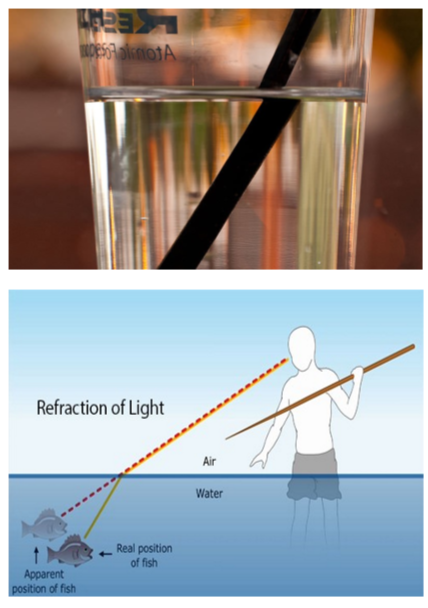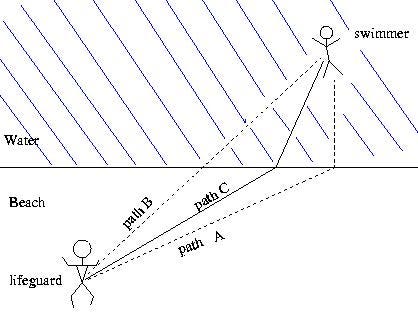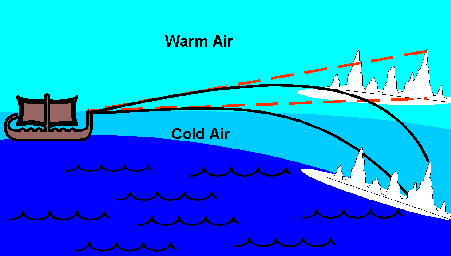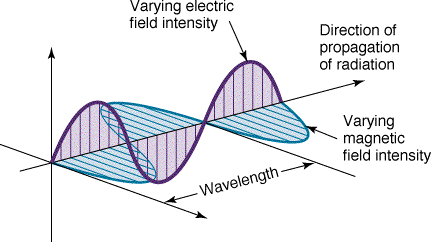The Physics of Road Heat Mirages
So what you’re seeing on the road is just light being bent in air which has been heated by the road. The first two points are intuitive enough; dark objects absorb more light-heat and hot air rises. It is the last point, that light bends because of the difference in the temperature of air, that leaves many scratching their heads.
What’s a Refractive Index?
To get a better understanding of what’s happening, let’s consider a more straightforward example of refraction in action.


One place that we’re all familiar with refraction is in water. Whether it’s that your straw looks a little off center in your glass or laughing at how your arm looks broken while wading in a pool, what you’re seeing is the change in direction of light caused by a difference in the refractive indexes of water and air.
What the index of refraction represents is the speed of light in a material. A higher index means a lower speed of light and vice versa.
Putting It Together
To bring it back to our heat mirage, hot air has a lower index of refraction than cold air because it is less dense and therefore light can travel through it more quickly.

An important principle of the classical picture of light is that it always follows the quickest path to its destination. This ‘quickest path’ is best explained with the metaphor of a lifeguard picking the fastest route to save a drowning man at the beach. Since the lifeguard is quicker on land than he is in the water, it’s faster for him to take a path that has an angle at the intersection of the two mediums. Light automatically ‘knows’ this fastest path and takes it every time.
So there you have it. The reason you sometimes see a wet patch on the road when there’s no water is because light from the blue sky is following a path of least resistance through different layers of air density created by a hot road heating up the air above it. The mirage disappears as you get closer because the angle becomes too small for the light to continue to bend toward you and the ‘shimmering’ of the mirage is from the continuous movement of the air layers.
And that’s it! If you have any questions or if you’d like another everyday phenomenon explained in terms of physics please comment below. Thanks for reading.
Fun fact: Mirages aren’t exclusive to hot climates. Those traveling in a cold environment can have a similar experience except the light is from farther along the horizon rather than from above.

.
.
.
But wait, what do you mean light ‘knows’ which path is fastest?
The Quantum Nature of Light
I left this part out until after the conclusion because it goes a little beyond the scope of what this article is trying to accomplish. In fact, I had to do some digging before I understood this for myself.
Now we may know the basics of what is happening. That is, light bending towards a different density of air. But WHY is this happening? What about light makes it change direction? To understand this, we’ll have to view light in terms of its wave nature and quantum-electrodynamics. Entire books have been written on this subject so, suffice to say, it is too dense to fully explain here, but the gist of it is the following. For this last part I have to assume some knowledge of both the wave nature of light and quantum mechanics.
Light is a small group of electromagnetic waves traveling through space. At any point in time, this quantum wave-packet is exploring all directions within its wavelength and propagating in the direction that is statistically favorable to its quantum state. It turns out that, because of destructive wave interference, this direction is the same direction that allows light to travel the farthest it can in that one frequency time period. This has the same result as light taking the shortest time to travel to a destination.


If you’d like to read more about why light bends I recommend this part of The Feynman Lectures on Physics.
Once again, thanks for reading. I hope I’ve stimulated your curiosity and given you new inspiration to never stop asking why.
